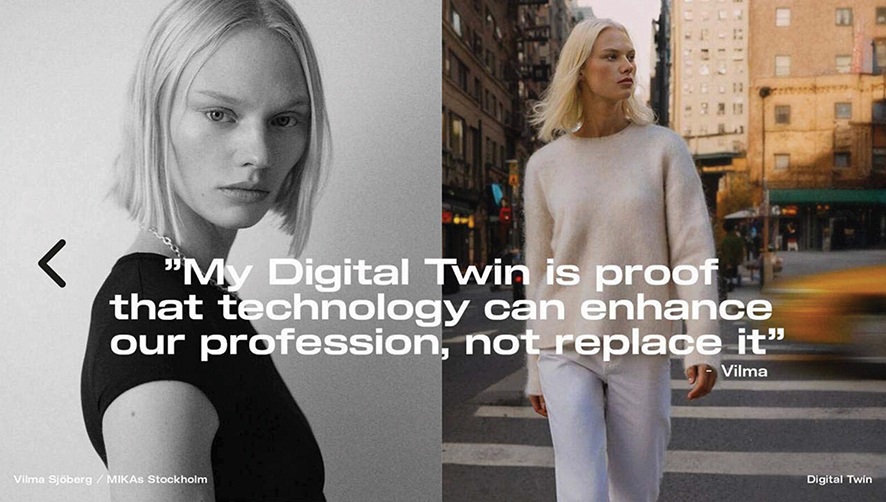In the latest campaign by Swedish fashion giant H&M, Georgian model Matilda Gvarliani smiles out at us with the same charisma and confidence that has made her a rising star — only this time, she isn’t entirely human. Or, rather, she is, but the version we see might not be. Using hyper-detailed photography and AI generation tools, H&M has created ultra-realistic digital twins of Gvarliani and 29 other models. According to the campaign’s own press release, even experts may struggle to tell the real from the synthetic.
In Gvarliani’s own words: “She’s just like me, without the jetlag.”
But what appears at first glance to be an impressive feat of technological progress masks a far deeper and more troubling cultural metamorphosis. This is not just a story about fashion or digital avatars. It’s a reflection of how we’re redefining reality, labor, and even personhood in the age of algorithmic aesthetics.
The Body as Commodity: From Oil Paint to Pixels
To understand the full impact of this campaign, we need to go back. In the Renaissance, the body became the central subject of European art, celebrated not just for its divine design but also for its individuality. Painters like Titian or Botticelli spent months capturing the fleeting expressions, textures, and peculiarities of their sitters. To be represented was to be seen, and to be seen was to be recognized.
Fast forward to today’s AI-generated modeling: the body is no longer captured but simulated. It is not so much a presence as a codebase — infinitely malleable, cost-efficient, and sleep-free. Aesthetic precision is no longer the domain of the painter or the photographer, but of the neural net. In effect, the model’s body has transitioned from a unique expressive form to a replicable product line.
What does it mean, then, to “own” your image, when that image can walk, talk, and pose without you?

Digital Doppelgängers and the Death of Labor
H&M preemptively acknowledged the possible backlash. Indeed, while the company promises that the rights to these digital doubles will remain with the models, and that they’ll receive full compensation, this carefully constructed PR shield doesn’t protect the thousands of workers surrounding them.
Makeup artists, hairstylists, set designers, lighting technicians, stylists, photo editors, craft services — all the intricate scaffolding of human labor behind a photoshoot suddenly becomes expendable. If a campaign can be executed in a server room instead of a studio, who is still invited to the set?
This isn’t just theory. In South Korea, AI-generated news anchors now deliver daily bulletins, replacing their human counterparts. In the US, the 2023 Hollywood writers’ strike included heated debates about AI-authored scripts. The fashion industry, with its hyper-visual and speed-driven economy, is the next frontier of displacement.
Labor economists call this “skill-biased technological change,” but from a cultural perspective, it’s something more acute: a quiet erasure of embodied knowledge — the kind that can’t be measured in efficiency graphs or KPIs.
“My Twin, My Self:” A Posthuman Identity Crisis
What happens to identity when it becomes transferable?
Theorist Donna Haraway predicted in her 1985 Cyborg Manifesto that the boundaries between human and machine would eventually dissolve. For Haraway, this hybridity was full of radical potential — to disrupt gender norms, capitalist hierarchies, and biological determinism. But in H&M’s campaign, we see something else entirely: hybridity deployed as marketing. It is not liberation from capitalism, but capitalism’s most recent costume change.
Even more fascinating is the philosophical echo of Baudrillard’s theory of the “simulacrum:” the copy that no longer refers to any original. When a digital Gvarliani performs as convincingly as the real one, she becomes not a representation, but a replacement. This collapses the concept of authenticity — a core value in both fashion and human intimacy.
The Balkanization of Reality: Where Is the “Real” Now?
Sociologically, we’re entering what Polish philosopher Zygmunt Bauman would call liquid modernity — a state of permanent flux where stable roles and values dissolve. In such a context, the distinction between “real” and “virtual” becomes increasingly irrelevant. Younger generations, especially those raised on Instagram filters and FaceTune, already interact with their own images as curated digital artifacts. For them, identity is performative and distributed, not anchored in a single, embodied self.
H&M’s campaign is simply the logical endpoint of this condition: the model no longer is — she is rendered.
Georgia on the Digital Frontline
It’s particularly poignant that a Georgian model is at the center of this global experiment. Georgia, long caught between tradition and techno-modernity, has seen a cultural renaissance in recent years — with its filmmakers, designers, and musicians gaining international recognition. Gvarliani’s participation signals that Georgia is no longer just catching up; it’s actively shaping the aesthetics of the digital future.
Yet this also raises concerns. Will Georgian creatives retain ownership of their own likenesses, narratives, and labor — or will they become raw material for Western corporations’ machine-learning pipelines? Cultural imperialism used to operate through language and symbols. Today, it operates through data rights and digital twins.

Between Empowerment and Exploitation
Yes, it’s empowering that Gvarliani can earn royalties while sleeping. But as with all capitalist promises of freedom, the devil is in the scalability. If her twin can work 24/7, will real models be pressured to compete with their own simulations? If “efficiency” becomes the new aesthetic, will future campaigns feature any actual humans at all?
And most crucially: can we truly consent to a system that rewrites the rules of labor, embodiment, and beauty — even as we smile for the (virtual) camera?
The Mirror Fights Back
In a now-famous 2021 essay, artist and writer James Bridle wrote: “The machine never stops learning. But we must stop and ask what it is being taught, and what it is teaching us in return.” H&M’s campaign with Matilda Gvarliani is a mirror. It reflects not only our faces, but our fears — of obsolescence, of duplication, of losing the ineffable presence that once made beauty beautiful.
For now, the digital twin is still tethered to her human original. But in the age of AI, even that thread may fray. The future of modeling, like the future of culture, will depend not just on innovation — but on the values we choose to preserve.
Until then, you might as well try to spot the difference.
Spoiler: There is none.
By Ivan Nechaev














